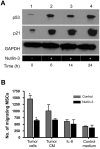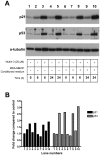P53 regulates the migration of mesenchymal stromal cells in response to the tumor microenvironment through both CXCL12-dependent and -independent mechanisms
- PMID: 24064862
- PMCID: PMC3834256
- DOI: 10.3892/ijo.2013.2109
P53 regulates the migration of mesenchymal stromal cells in response to the tumor microenvironment through both CXCL12-dependent and -independent mechanisms
Abstract
Mesenchymal stromal cells (MSCs) are multipotent fibroblast-like cells located in the bone marrow that localize to areas of tissue damage including wounds and solid tumors. Within the tumor microenvironment, MSCs adopt the phenotype of carcinoma-associated fibroblasts (CAFs) and stimulate tumor growth. Production of the chemokine CXCL12, also known as stromal cell-derived factor 1 (SDF-1), by MSCs is required for their in vitro migration in response to tumor cells and has also been implicated in stimulation of tumor growth. The tumor suppressor p53 regulates cellular migration, CXCL12 production and the promotion of tumor growth by carcinoma-associated fibroblasts (CAFs). We investigated the role of p53 in MSC migration to tumors. P53 inhibits the migration of MSCs in response to tumor cells in conjunction with a decrease in CXCL12 transcription. Conversely, decreased p53 activity leads to enhanced MSC migration. Interestingly, increased p53 activity inhibits MSC migration even in the context of high concentrations of exogenous CXCL12. These data show that stromal p53 status impacts the recruitment of MSCs to solid tumors through both regulation of CXCL12 production as well as other mechanisms. Stromal p53 may influence other important aspects of tumor biology such as tumor growth and metastasis through mechanisms distinct from CXCL12.
Figures








Similar articles
-
p53 activation of mesenchymal stromal cells partially abrogates microenvironment-mediated resistance to FLT3 inhibition in AML through HIF-1α-mediated down-regulation of CXCL12.Blood. 2011 Oct 20;118(16):4431-9. doi: 10.1182/blood-2011-02-334136. Epub 2011 Aug 25. Blood. 2011. PMID: 21868571 Free PMC article.
-
Activation of signal transducers and activators of transcription 3 and focal adhesion kinase by stromal cell-derived factor 1 is required for migration of human mesenchymal stem cells in response to tumor cell-conditioned medium.Stem Cells. 2009 Apr;27(4):857-65. doi: 10.1002/stem.23. Stem Cells. 2009. PMID: 19350687
-
Protein kinase C zeta regulates interleukin-8-mediated stromal-derived factor-1 expression and migration of human mesenchymal stromal cells.Exp Cell Res. 2010 Feb 15;316(4):593-602. doi: 10.1016/j.yexcr.2009.11.011. Epub 2009 Nov 24. Exp Cell Res. 2010. PMID: 19944094
-
Downregulation of CXCL12 in mesenchymal stromal cells by TGFβ promotes breast cancer metastasis.Oncogene. 2017 Feb 9;36(6):840-849. doi: 10.1038/onc.2016.252. Epub 2016 Sep 26. Oncogene. 2017. PMID: 27669436 Free PMC article.
-
Mesenchymal Stromal Cells Can Regulate the Immune Response in the Tumor Microenvironment.Vaccines (Basel). 2016 Nov 8;4(4):41. doi: 10.3390/vaccines4040041. Vaccines (Basel). 2016. PMID: 27834810 Free PMC article. Review.
Cited by
-
CXCL12/CXCR4: a symbiotic bridge linking cancer cells and their stromal neighbors in oncogenic communication networks.Oncogene. 2016 Feb 18;35(7):816-26. doi: 10.1038/onc.2015.139. Epub 2015 May 11. Oncogene. 2016. PMID: 25961926 Review.
-
Bone mesenchymal stem cells are recruited via CXCL8-CXCR2 and promote EMT through TGF-β signal pathways in oral squamous carcinoma.Cell Prolif. 2020 Aug;53(8):e12859. doi: 10.1111/cpr.12859. Epub 2020 Jun 26. Cell Prolif. 2020. PMID: 32588946 Free PMC article.
-
Association of high-sensitivity C-reactive protein and odds of breast cancer by molecular subtype: analysis of the MEND study.Oncotarget. 2021 Jun 22;12(13):1230-1242. doi: 10.18632/oncotarget.27991. eCollection 2021 Jun 22. Oncotarget. 2021. PMID: 34194621 Free PMC article.
-
Adipose-Derived Mesenchymal Stem Cell (MSC) Immortalization by Modulation of hTERT and TP53 Expression Levels.J Pers Med. 2023 Nov 20;13(11):1621. doi: 10.3390/jpm13111621. J Pers Med. 2023. PMID: 38003936 Free PMC article.
-
Regulation of the inflammatory profile of stromal cells in human breast cancer: prominent roles for TNF-α and the NF-κB pathway.Stem Cell Res Ther. 2015 May 1;6(1):87. doi: 10.1186/s13287-015-0080-7. Stem Cell Res Ther. 2015. PMID: 25928089 Free PMC article.
References
-
- Studeny M, Marini FC, Dembinski JL, Zompetta C, Cabreira-Hansen M, Bekele BN, Champlin RE, Andreeff M. Mesenchymal stem cells: potential precursors for tumor stroma and targeted-delivery vehicles for anticancer agents. J Natl Cancer Inst. 2004;96:1593–1603. - PubMed
-
- Studeny M, Marini FC, Champlin RE, Zompetta C, Fidler IJ, Andreeff M. Bone marrow-derived mesenchymal stem cells as vehicles for interferon-beta delivery into tumors. Cancer Res. 2002;62:3603–3608. - PubMed
-
- Shen FH, Visger JM, Balian G, Hurwitz SR, Diduch DR. Systemically administered mesenchymal stromal cells transduced with insulin-like growth factor-I localize to a fracture site and potentiate healing. J Orthop Trauma. 2002;16:651–659. - PubMed
-
- Rochefort GY, Delorme B, Lopez A, Herault O, Bonnet P, Charbord P, Eder V, Domenech J. Multipotential mesenchymal stem cells are mobilized into peripheral blood by hypoxia. Stem Cells. 2006;24:2202–2208. - PubMed
-
- Pittenger MF, Mackay AM, Beck SC, et al. Multilineage potential of adult human mesenchymal stem cells. Science. 1999;284:143–147. - PubMed
Publication types
MeSH terms
Substances
LinkOut - more resources
Full Text Sources
Other Literature Sources
Research Materials
Miscellaneous

